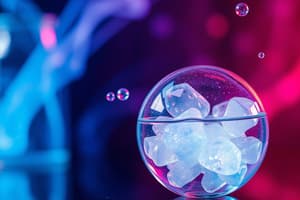Podcast
Questions and Answers
What is the basic unit of matter?
What is the basic unit of matter?
- Compounds
- Elements
- Atoms (correct)
- Molecules
Which of the following describes a physical change?
Which of the following describes a physical change?
- Rust forming on iron
- Melting of ice into water (correct)
- Digesting food
- Baking a cake
What is the formula for calculating density?
What is the formula for calculating density?
- P = V/M
- P = M + V
- P = M/V (correct)
- P = M - V
Which of the following is a pure substance?
Which of the following is a pure substance?
Which statement compares mass and weight correctly?
Which statement compares mass and weight correctly?
What distinguishes a mixture from a pure substance?
What distinguishes a mixture from a pure substance?
Which of the following scenarios is an example of a chemical change?
Which of the following scenarios is an example of a chemical change?
When measuring volume, which method is suitable for irregular shaped solids?
When measuring volume, which method is suitable for irregular shaped solids?
What is the effect on the volume of gas when the temperature increases while keeping pressure constant, according to Charles's Law?
What is the effect on the volume of gas when the temperature increases while keeping pressure constant, according to Charles's Law?
What two factors primarily affect kinetic energy?
What two factors primarily affect kinetic energy?
In the scenario where Train A has a mass of 300 kg and Train B has a mass of 295 kg, both traveling at 80 km/h, which train uses more kinetic energy?
In the scenario where Train A has a mass of 300 kg and Train B has a mass of 295 kg, both traveling at 80 km/h, which train uses more kinetic energy?
What are the correct units of measurement for work?
What are the correct units of measurement for work?
If Rivan exerts a 13 N force moving an object 16 meters and Yasin exerts a 17 N force moving the same object 19 meters, who does more work?
If Rivan exerts a 13 N force moving an object 16 meters and Yasin exerts a 17 N force moving the same object 19 meters, who does more work?
Which statement accurately describes a difference between homogeneous and heterogeneous mixtures?
Which statement accurately describes a difference between homogeneous and heterogeneous mixtures?
What is the primary purpose of the water displacement method?
What is the primary purpose of the water displacement method?
Which of the following accurately defines a pure substance?
Which of the following accurately defines a pure substance?
What is the main factor that affects a change of state in matter?
What is the main factor that affects a change of state in matter?
How do particles behave in a solid compared to a gas?
How do particles behave in a solid compared to a gas?
Which statement accurately depicts an example of a chemical change?
Which statement accurately depicts an example of a chemical change?
According to gas laws, what happens to the volume of a gas if the pressure is decreased while temperature is held constant?
According to gas laws, what happens to the volume of a gas if the pressure is decreased while temperature is held constant?
Which of the following describes an inversely proportional relationship?
Which of the following describes an inversely proportional relationship?
Flashcards
What is energy?
What is energy?
Energy is the ability to do work or cause change.
What is work in physics?
What is work in physics?
Work is done when a force causes an object to move a certain distance.
What is kinetic energy?
What is kinetic energy?
Kinetic energy is the energy of motion. The faster an object moves, the more kinetic energy it has. It depends on mass and speed.
What is potential energy?
What is potential energy?
Signup and view all the flashcards
Which situation has more work done: Rivan (13 N, 16 meters) or Yasin (17 N, 19 meters)?
Which situation has more work done: Rivan (13 N, 16 meters) or Yasin (17 N, 19 meters)?
Signup and view all the flashcards
Atom
Atom
Signup and view all the flashcards
Element
Element
Signup and view all the flashcards
Molecule
Molecule
Signup and view all the flashcards
Compound
Compound
Signup and view all the flashcards
Physical Property
Physical Property
Signup and view all the flashcards
Chemical Property
Chemical Property
Signup and view all the flashcards
Physical Change
Physical Change
Signup and view all the flashcards
Chemical Change
Chemical Change
Signup and view all the flashcards
Homogeneous Mixture
Homogeneous Mixture
Signup and view all the flashcards
Heterogeneous Mixture
Heterogeneous Mixture
Signup and view all the flashcards
What is Matter?
What is Matter?
Signup and view all the flashcards
Pure Substance
Pure Substance
Signup and view all the flashcards
Solid
Solid
Signup and view all the flashcards
Liquid
Liquid
Signup and view all the flashcards
Study Notes
6th Grade Science Study Guide - Review Week
-
Exam Focus: The exam assesses understanding and application of concepts, not just memorization of the study guide examples.
-
Study Guide Purpose: Examples in the study guide are designed to help understand concepts and practice skills. Actual exam questions may differ.
-
Exam Goal: Demonstrate comprehension and application of the core concepts, not just rote memorization.
Topic 1: Introduction to Matter
-
Standard (MS-PS1-1): Develop models to describe the atomic composition of simple molecules and extended structures.
-
Lesson 1: Describing and Classifying Matter (Google Classroom - week 2, review slides, illustrations, Savvas Etext, worksheets)
- Key Concepts: Describe what matter is composed of. Example: atoms, elements, molecules, and compounds.
-
Lesson 2: Measuring Matter (Google Classroom - week 4, 5, & 6, review slides, illustrations, notebooks, Savvas Etext, worksheets)
- Key Concepts: Identify properties of matter (mass, weight, volume, density)
- Compare and contrast mass and weight.
- Calculate mass, volume, weight, and density.
- Calculate the volume of regular and irregular solids.
- Calculate density using the formula P = M/V
-
Lesson 3: Changes in Matter (Google Classroom - week 6, review slides, charts, illustrations, Savvas Etext, notebook, worksheets)
- Key Concepts: Differentiate between physical and chemical changes. Analyze and interpret scenarios to determine if a change is physical or chemical.
Topic 2: Solid, Liquid, and Gas
-
Standard (MS-PS1-4): Develop a model that predicts and describes changes in particle motion, temperature, and state of a pure substance when thermal energy is added or removed.
-
Lesson 1: States of Matter (Google Classroom - week 7& 8; review slides, illustrations, Savvas Etext, notebooks, worksheets)
- Key Concepts: Explain similarities and differences between solids, liquids, and gases.
- Demonstrate how particle arrangement and movement compare in these states. Explain the relationship between particle motion and state of matter.
-
Lesson 2: Changes of State (Google Classroom - week 9, review - slides, illustrations, and worksheets)
- Key Concepts: Describe what happens to particles during changes of state (solid, liquid, gas).
- Identify the main factor affecting state changes—thermal energy.
- Describe particle behavior as thermal energy increases (speed/motion).
-
Lesson 3: Gas Behavior (Google Classroom - week 10, review - slides, illustrations, and worksheets)
- Key Concepts: Differentiate between Boyle's, Charles and Lussac's gas laws.
- Describe the relationships between pressure and volume in gases.
- Understand inversely proportional relationships (pressure and volume).
- Understand directly proportional relationships (temperature and volume).
- Describe the relationship between temperature and pressure in gases.
Topic 3: Energy
-
Standard (MS-PS3-1): Construct and interpret graphical displays of data to describe the relationships of kinetic energy to the mass of an object and to the speed of an object.
-
Lesson 1: Energy, Motion, Force and Work (Google Classroom - week 10& 11, review slides, illustrations, and worksheets)
- Key Concepts: Define energy, motion, force, and work.
- Explain the relationship between energy, motion, and force.
- Calculate work done.
-
Lesson 2: Kinetic Energy and Potential Energy (Google Classroom - week 13 & 14, review - slides, illustrations, and worksheets)
- Key Concepts: Define kinetic and potential energy.
- Describe factors affecting kinetic and potential energy.
- Calculate kinetic and potential energy.
Studying That Suits You
Use AI to generate personalized quizzes and flashcards to suit your learning preferences.



